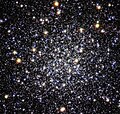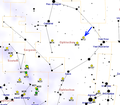| Messier 12 | |
|---|---|
 Globular cluster Messier 12 in Ophiuchus | |
| Observation data (J2000 epoch) | |
| Class | IX [1] |
| Constellation | Ophiuchus |
| Right ascension | 16h 47m 14.18s [2] |
| Declination | –01° 56′ 54.7″ [2] |
| Distance | 16.44 ± 0.16 kly (5.04 ± 0.05 kpc) [3] |
| Apparent magnitude (V) | 6.7 [4] |
| Apparent dimensions (V) | 16.0′ |
| Physical characteristics | |
| Mass | 8.7×104 [5] M☉ |
| Radius | 37.2 ly [NB 1] |
| Metallicity | [Fe/H] = –1.14 [6] dex |
| Estimated age | 13.8 ± 1.1 Gyr [3] |
| Other designations | NGC 6218 [7] |
Messier 12 or M 12 (also designated NGC 6218) is a globular cluster in the constellation of Ophiuchus. It was discovered by the French astronomer Charles Messier on May 30, 1764, who described it as a "nebula without stars". [8] In dark conditions this cluster can be faintly seen with a pair of binoculars. Resolving the stellar components requires a telescope with an aperture of 8 in (20 cm) or greater. [9] In a 10 in (25 cm) scope, the granular core shows a diameter of 3′ (arcminutes) surrounded by a 10′ halo of stars. [8]
Contents
M12 is roughly 3° [9] northwest from the cluster M10 and 5.6° east southeast from star Lambda Ophiuchi. It is also located near the 6th magnitude 12 Ophiuchi. [10] The cluster is about 16,400 light-years (5,000 parsecs) [3] from Earth and has a spatial diameter of about 75 light-years. The brightest stars of M12 are of 12th magnitude. M10 and M12 are only a few thousand light-years away from each other and each cluster would appear at about magnitude 4.5 from the other. [10] With a Shapley-Sawyer rating of IX, [1] it is rather loosely packed for a globular and was once thought to be a tightly concentrated open cluster. Thirteen variable stars have been recorded in this cluster. M12 is approaching us at a velocity of 16 km/s. [11]
A study published in 2006 concluded that this cluster has an unusually low number of low-mass stars. The authors surmise that they were stripped from the cluster by passage through the relatively matter-rich plane of the Milky Way. [12]



